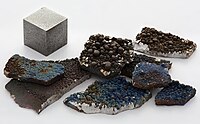
Photo from wikipedia
The variation in the morphology and electronic structure of copper during the electroreduction of CO2 into valuable hydrocarbons and alcohols was revealed by combining in situ surface- and bulk-sensitive X-ray… Click to show full abstract
The variation in the morphology and electronic structure of copper during the electroreduction of CO2 into valuable hydrocarbons and alcohols was revealed by combining in situ surface- and bulk-sensitive X-ray spectroscopies with electrochemical scanning electron microscopy. These experiments proved that the electrified interface surface and near-surface are dominated by reduced copper. The selectivity to the formation of the key C–C bond is enhanced at higher cathodic potentials as a consequence of increased copper metallicity. In addition, the reduction of the copper oxide electrode and oxygen loss in the lattice reconstructs the electrode to yield a rougher surface with more uncoordinated sites, which controls the dissociation barrier of water and CO2. Thus, according to these results, copper oxide species can only be stabilized kinetically under CO2 reduction reaction conditions.
Journal Title: ACS Energy Letters
Year Published: 2020
Link to full text (if available)
Share on Social Media: Sign Up to like & get
recommendations!